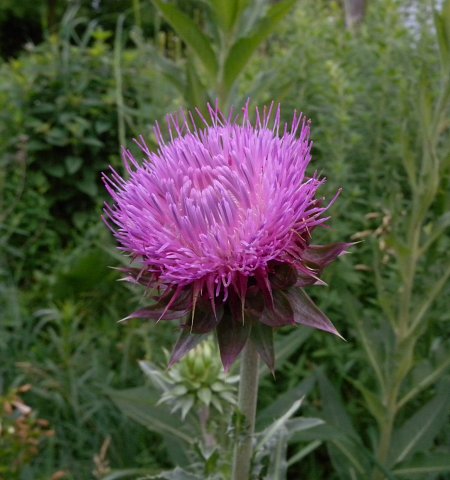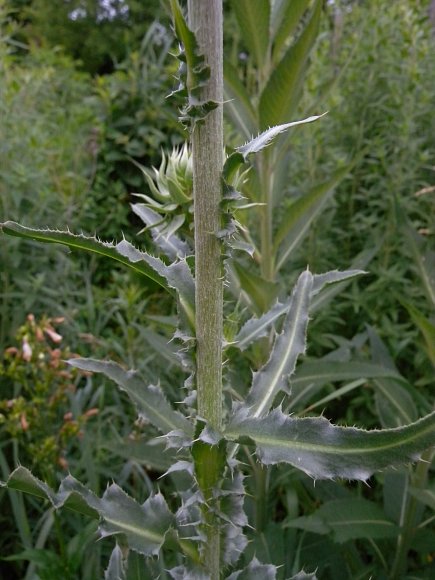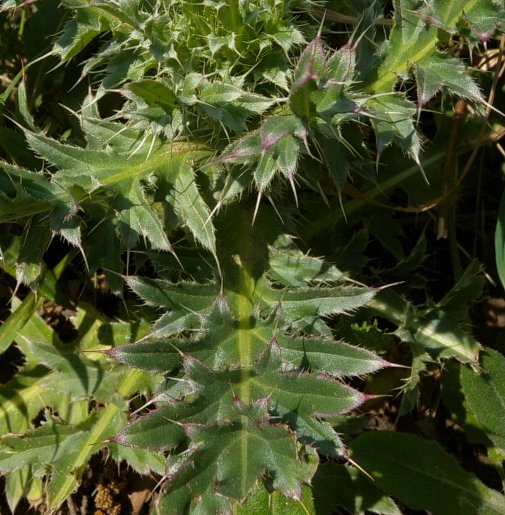
The blooming period occurs from early summer into the fall, lasting 1-4 months. The flowerheads are fragrant. Afterwards, the florets are replaced by achenes (4-5 mm. in length) with large tufts of hair. These achenes are bullet-shaped, slightly flattened, and ribbed. The primary hairs that are above these achenes have minute lateral hairs (may require 10x magnification to see). The achenes are distributed primarily by the wind. The root system develops a fleshy taproot.
Cultivation: The preference is full sun, mesic conditions, and calcareous soil that is derived from either limestone or sand. However, Nodding Thistle (Carduus nutans) will adapt to almost any soil that is not extremely acidic. The size of individual plants can vary considerably depending on soil fertility and moisture levels. This thistle can reseed itself aggressively and become invasive. The seeds can remain viable for 3 or more years.
Range & Habitat: The non-native Nodding Thistle (Carduus nutans) is occasional in most areas of Illinois (see Distribution Map), and it is probably still spreading within the state. This thistle is native to Eurasia and northern Africa; it was accidentally introduced into North America during the 19th century, possibly from dumped ship ballast along the east coast. In Illinois and other parts of North America, habitats include savannas, pastures, fallow fields, roadsides, areas along railroads, waste areas, and gardens or yards that use transported soil containing the seeds of this thistle. Nodding Thistle is particularly common in areas with calcareous sand (e.g., near major lakes) and limestone-derived soil. Disturbed areas are strongly preferred.

Faunal Associations: The flowerheads are cross-pollinated primarily by bumblebees and other long-tongued bees, butterflies, and skippers. In the absence of cross-pollination, the florets of the flowerheads are self-fertile. Both nectar and pollen are available as floral rewards. Because Nodding Thistle (Carduus nutans) is regarded as invasive in some parts of North America, various insects have been introduced from abroad to function as biocontrol agents. These species include: Rhinocyllus conicus (Thistlehead Weevil), whose larvae feed on the flowerheads; Trichosirocalus horridus (Thistle Crown Weevil), whose larvae feed on the growing points of rosettes and young shoots; Cheilosa corydon (Thistle Crown Fly), whose larvae burrow into shoots; Cassida rubiginosa (Thistle Tortoise Beetle), whose larvae and adults feed on leaves; and Psylliodes chalcomerus (Musk Thistle Leaf Beetle), whose larvae bore through stems, while the adults feed on leaves. Other insect feeders include Platyptilia carduidactylus (Artichoke Plume Moth) and Brachycaudus cardui (Thistle Aphid). The seeds of this thistle are eaten by a songbird, the Eastern Goldfinch, and the tufted hairs of its seeds are used in the construction of this bird's nests. Because of the spiny foliage, Nodding Thistle is rarely eaten by mammalian herbivores. However, sometimes cattle, sheep, and goats will eat the flowerheads or seedheads. It is unclear to what extent the seeds can survive passage in the digestive tracts of these animals, and thus their role in seed dispersal is still unclear.

Photographic Location: The photographed plant was cultivated in the webmaster's wildflower garden in Urbana, Illinois. However, this plant was found originally in the yard of the webmaster's apartment complex, where it had been transported in contaminated soil that was purchased from a local garden center.
Comments: Nodding Thistle (Carduus nutans) has very showy and fragrant flowerheads, while its foliage is quite spiny. Until the nodding flowerheads are produced, it can be difficult to distinguish from other thistles. Like the Eurasian Bull Thistle (Cirsium vulgare), Nodding Thistle can be distinguished from native thistles by the spines on its stems (as derived from the decurrent margins of its leaves). It can be distinguished from the Bull Thistle by differences in the shape, size, and color of their respective phyllaries (floral bracts). The phyllaries of Nodding Thistle are larger in size, more broad at their bases, and become purple-colored when the flowerheads bloom; the phyllaries of Bull Thistle remain green at this time. In addition, the flowerheads of Nodding Thistle are usually more broad than those of Bull Thistle. Thistle species in the Carduus genus differ from thistle species in the Cirsium genus by the structure of the tufted hairs above their seeds. The tufted hairs of Carduus spp. (Musk Thistles) have barbed hairs from minute lateral hairs, while the tufted hairs of Cirsium spp. (Thistles) are more plumose (feathery) from longer lateral hairs. This is why Carduus nutans is sometimes referred to as the 'Plumeless Thistle,' even though its seeds have tufts of hair.